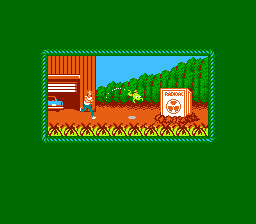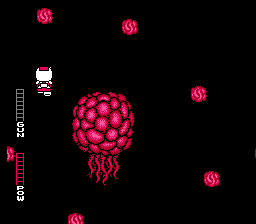![[IMAGE]](bm-titl.gif)
![[IMAGE]](bm-titl.gif)
Publisher: Sunsoft
Genre: Action
Year of Release:
1989
Date Reviewed: 2-21-98 ("Old Era")
In what I term the
"NES Preservation Era" (currently perpetuated by pages like mine), several games
have earned recognition among the proprieters of the era's pages that were
passed-over during their original release. For various reasons, these games were
ignored during their first advents on the NES (though it was typically because
they were produced by obscure companies, or released at the same time as
stellarly popular games.) There are two games in particular that have achieved
this belated recognition. Blaster Master is one of them (the other is Crystalis,
which will be reviewed at a later date.) Now, while I can certainly see the
logic behind the arguments of those who have praised this game, I cannot
simultaneously join them. I have no aversion to Blaster Master. It is a good
game. However, this is a game with which I tend to accentuate the
negative.
Blaster Master is one of those games in which the plot exists
only to be ignored once play begins, and, in the case of this particular plot,
that is probably best. Now, I know that I have ranted and raved about stupid
plots on many occasions now. However, if you ask any NES aficianado, they will
concur with my debasement of this game's plot. The game begins with Jason, a
common American teenager (does it seem to you that a lot of these became heroes
in NES games?), tending to his frog (Fred), whereupon Fred leaps out of his
little cellarium, with Jason reaching distantly behind. Fred then hops out of
Jason's house (God knows how he got the door open), and into the back yard, with
Jason trudging along slowly behind (apparently Fred is one of those
well-conditioned Jumping Contest frogs.) Moving forth, Fred hops on top of a
radioactive generator that seems to be quite at home in Jason's yard, and
(rather than contracting cancer, which would be the logical result) grows to the
size of roughly three men. After that, the generator disappears, and Fred hops
down the hole that is left. Jason follows, and discovers a protective suit and
giant otherworldly tank. Seeing no sign of Fred, Jason puts on the suit, hops in
the tank, and sets out to find his pet.
The world before Jason is
bizarre, populated primarily by what are either robotic monsters or humans in
suits much like Jason's. It is upon entry into this world that the plot is
forgotten, and the action takes center stage. The action in this game is
interesting, divided into two interfaces throughout play. The first of these
interfaces is the side-scrolling action (which one might call the overworld.) It
is here that the player navigates throughout the world, trying to figure out
where to go next. In this interface, it is adivsed that the player STAY IN THE
TANK as much as possible, letting Jason out only to enter into the caverns, or
destroy an obstacle that is set too low for the tank to hit. The enemies in this
world are much more powerful than those in the caves, and cannot be easily
destroyed with Jason's feeble gun.
The second interface, as alluded to,
is what I call the "cave interface." Throughout the "overworld", the player will
notice several doors that are too small for the tank to enter. Jason can only
enter these doors alone. Here, Jason's inventory is extended beyond the
relatively useless gun to contain the much needed grenades. Aside from being
notedly more powerful than the gun, these grenades possess a strange power
afforded them by a glitch in the program. That is, once they have exploded, the
grenades continue to cause damage to certain bosses when the game is paused.
This does not work in all cases, but it is a fallibility best taken advantage
of. Most of the caverns behind these doors are merely havens containing powerups
for Jason. However, one of these caverns per level contains the "boss". Now, one
might be wondering why a young kid looking for his frog would want to waste his
time on a side trip to kill some otherworldly creature. Well, each of the bosses
guards an attachment for Jason's tank that is needed to advance to the next
level.
Most of the music of this game is noticeably similar to the game's
other songs. The synthesized instruments are all pretty much the same. However,
the original paradigm after which the songs are modeled is quite good. Thus, the
game's entire soundtrack is equally entertaining.
I have never advanced
even as far as the fourth level, and so cannot comment on the majority of the
game. However, what I have seen of the game is, in truth, pretty repetitive. The
action is somewhat fun, but, because the majority of the enemies are robotic,
nearly all of them are gray. I am a lover of earthtones in clothing, but, in
video games, they tend to be quite dulling, particularly when used to the degree
that they are in this game. Also, the caverns containing the bosses tend to be
winding and labyrinthian. While this has been proven to work in some games
(Zelda, Crystalis, e.g.), it is not as effective in the already arduous outer
world of Blaster Master. In this game with no save option, and a huge,
side-scrolling world, taking forty minutes to figure out where the hell you're
supposed to go in one of a smattering of caverns is nothing more than excessive
and frustrating. By the third level, I began to wonder how much longer I would
have to play, and the game unbecame fun.
My Score: 6

If Jason had just written his
congressman and had the radioactive box hauled away, none of this would have
happened.

Why is there a sky?
Isn't this supposed to be underground?

I wish
my brain could do that.
>Return to the main page - The NES
Enshrined
Return to the review index - Game
Reviews